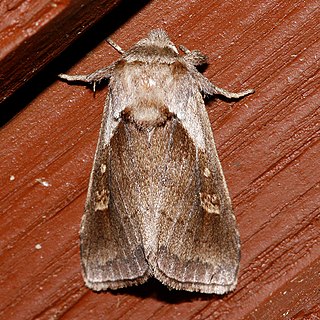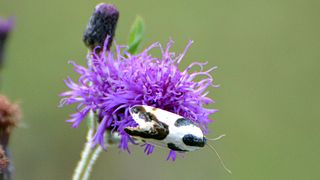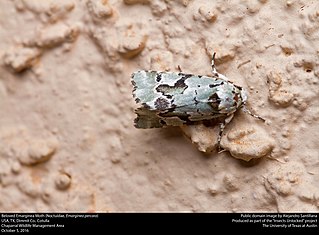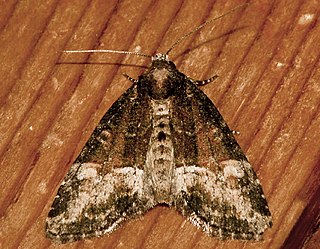Phlyctaina is a monotypic litter moth genus of the family Erebidae. Its only species, Phlyctaina irrigualis, is found in North America. Both the genus and species were first described by Heinrich Benno Möschler in 1890.

Coelodasys errucata is a species of moth in the family Notodontidae. It was first described by Harrison Gray Dyar Jr. in 1906, and is found in North America.

Bellura obliqua, the cattail borer, is a species of cutworm or dart moth in the family Noctuidae. It was first described by Francis Walker in 1865 and it is found in North America.

Neoligia exhausta, the exhausted brocade, is a species of cutworm or dart moth in the family Noctuidae.

Eudocima serpentifera is a species of fruit-piercing moth in the family Erebidae first described by Francis Walker in 1858. It is found in North America.

Nola pustulata, the sharp-blotched nola, is a nolid moth. The species was first described by Francis Walker in 1865.

Tarache delecta, the delightful bird dropping moth, is a bird dropping moth in the family Noctuidae. The species was first described by Francis Walker in 1858.

Heterocampa biundata, the wavy-lined heterocampa, is a species of moth in the family Notodontidae. It was first described by Francis Walker in 1855 and it is found in North America.

Emarginea percara, the beloved emarginea moth, is a moth in the family Noctuidae. The genus was erected by Herbert Knowles Morrison in 1875.
Neoligia tonsa is a species of cutworm or dart moth in the family Noctuidae.

Lacinipolia stricta, the brown arches moth, is a species of cutworm or dart moth in the family Noctuidae. It is found in North America.
Lacinipolia aileenae is a moth genus or species of cutworm or dart moth in the family Noctuidae. It is found in North America.
Zale declarans, the Dixie zale, is an owlet moth in the family Erebidae. The species was first described by Francis Walker in 1858. It is found in North America.

Hemeroplanis habitalis, the black-dotted hemeroplanis, is a moth in the family Erebidae. The moth was erected by Francis Walker in 1859.

Nycteola metaspilella, the forgotten frigid owlet, is a nolid moth. The species was first described by Francis Walker in 1866. It is found in North America.

Lesmone detrahens, the detracted owlet, is an owlet moth in the family Erebidae. The species was first described by Francis Walker in 1858.

Marathyssa basalis, the light marathyssa, is a moth in the family Euteliidae. It is found in North America. The species was first described by Francis Walker in 1865.
Zale peruncta is a species of moth in the family Erebidae. It is found in North America.

Neoligia subjuncta is a species of cutworm or dart moth in the family Noctuidae. It is found in North America.
Elymiotis notodontoides, the glossy prominent, is a species of moth in the family Notodontidae. It was first described by Francis Walker in 1857 and it is found in North America.














